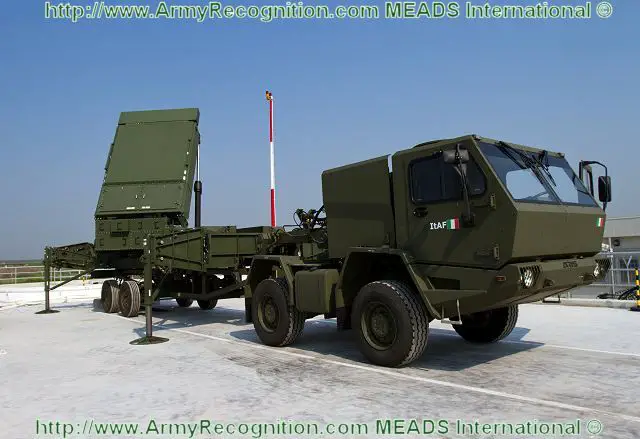| a | |||||
Defence & Security Industry News - MBDA |
|||||
| Tuesday, September 23, 2014 03:52 PM | |||||
| MEADS Multifunction Fire Control Radar Proves Capabilities in Performance Tests | |||||
The Medium Extended Air Defense System (MEADS) program has completed a six-week performance test of its 360-degree Multifunction Fire Control Radar (MFCR) at Pratica di Mare Air Force Base near Rome, Italy, and at MBDA Germany’s air defense center in Freinhausen in the presence of the German customer and guests from MEADS partner nations. This was the first time the MFCR has been operated in Germany. |
|||||
Medium Extended Air Defense System (MEADS) presentation at MSPO 2014 |
|||||
“The
latest test gives again evidence of the maturity of the MEADS
development results. They form an excellent basis for Germany’s
TLVS future air defense system. A future air defense system based on MEADS
technologies is designed to fulfill requirements for an advanced tactical
air and missile defense system that anticipates future threats. Competing
systems would require further development for achieving the advanced MEADS
capabilities,” stated Siegfried Bücheler, Director Programs
and Supply Chain at MBDA Germany and Chairman of the Board of Directors
at MEADS International. During the tests, the MEADS MFCR successfully demonstrated several advanced capabilities, many of which are critical for ground-mobile radar. Capabilities tested include tracking and canceling jamming signals; searching, cueing and tracking in ground clutter; and successfully classifying target data using kinematic information. “The MEADS MFCR combines extraordinary capability and cost effectiveness,” said Gregory Kee, General Manager of the NATO MEADS Management Agency. “It can detect and track advanced threats with 360-degree coverage, is highly mobile and C-130 transportable.” MEADS radars are designed to protect troops and assets on today’s 360-degree battlefield because missile attacks are omnidirectional. Using plug-and-fight capability, the MFCR acts as a node on the MEADS network, and like all other MEADS major end items, can be dynamically added or removed as missions dictate without shutting down the system. |
|||||
 MEADS
X-Band Multifunction Fire Control Radar (MFCR) MEADS
X-Band Multifunction Fire Control Radar (MFCR) |
|||||
“We
are thrilled with the maturity of this radar,” said Marco Riccetti,
technical director for MEADS International. “The MFCR has an extraordinary
capability to detect and track ballistic missiles, cruise missiles, aircraft
and unmanned aerial vehicles. Its 360-degree capabilities provide added
protection against next-generation threats for military sites and civilian
populations.” The X-band MFCR employs active phased array technology
using transmit/receive components developed in Germany. It provides precision
tracking and wideband discrimination and classification capabilities.
An advanced Mode 5 Identification Friend or Foe subsystem allows for improved
threat identification. If required, the radar can provide full fire control
and limited surveillance capabilities. For future air defense applications, Freinhausen offers the capabilities for assembling and testing sensors and a wide range of C2 and weapon deployment systems, up to and including the preparation and follow-up of flight trials. Active 360-degree transmission by search radars is also possible, as are the integration and testing of components of a future air defense network. Furthermore, the datalink between the Freinhausen and Schrobenhausen sites offers the option of working on integration and test activities at either location. The linking of the future MEADS System Integration Laboratory (SIL) in Schrobenhausen with the test facilities at Freinhausen is a good example of this. With the facilities already available there, Freinhausen will make a significant contribution to the further development of Germany’s air defense capabilities. |
|||||
MEADS Multifunction Fire Control Radar Proves Capabilities in Performance Tests
- Posted On














